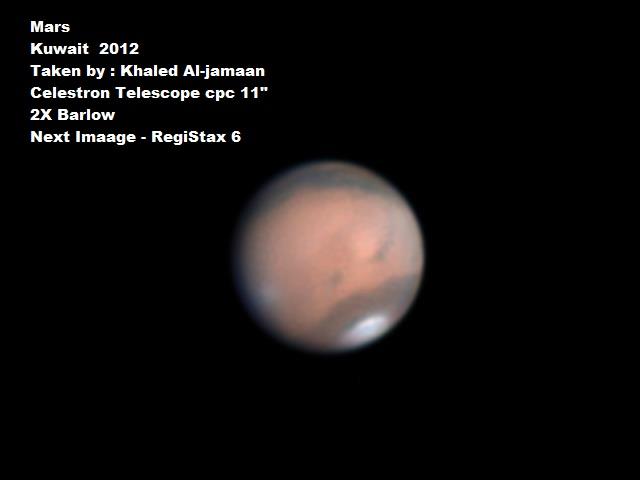- This topic has 2 replies, 3 voices, and was last updated 7 years, 9 months ago by
 Dr Richard John McKim.
Dr Richard John McKim.
-
AuthorPosts
-
29 August 2017 at 12:09 pm #573822
 DawsonParticipant
DawsonParticipantIf amateur astronomers image Mars and cloud features are detected, these always appear to be at the edge of the limbs of the planet, hardly ever seen traversing the face of the planet. Why is this?
A recently uploaded Mars from the Member Pages shows this well:
Attachments:
29 August 2017 at 2:20 pm #578506 David BaseyParticipant
David BaseyParticipantJames,
From the programme of the Mars Section:-
“Other atmospheric phenomena White clouds, frequently seen at the limb and terminator, can occur in conjunction with specific topographic features, such as the great volcanoes like Olympus Mons, those in the Tharsis region, or Elysium Mons. Such topographic or orographic clouds are carried round with the planet’s rotation, and may be enhanced with the recommended blue and green filters. The clouds over the Tharsis volcanoes can sometimes coalesce on the evening side and form a ‘W’-shaped cloud (or ‘M’ for ‘Mars’ if viewed with north up). Some basin areas act as cold-traps for volatiles: thus Argyre and Hellas can show frost patches at the appropriate season. Another interesting phenomenon is a band of equatorial white cloud, the so-called Equatorial Cloud Band, which is best seen in blue or violet light and most apparent between about Ls = 50° to 145°, and whose brighter extremities at the E and W limbs give rise to the evening and morning clouds viewed in white light.”
The last part of this probably applies to the image you have displayed as Ls at the time was 78.
I guess the reason they appear brighter at the limb and terminator is that you are viewing obliquely, looking through a greater depth of cloud than when they are on the meridian and you look straight through them.
David.
29 January 2018 at 2:31 pm #579014 Dr Richard John McKimParticipant
Dr Richard John McKimParticipantI must have missed the original post but the reply by David Basey is spot on. The optical depth is important, given the rather thin atmosphere of Mars. Some types of cloud on Mars, like the north polar spiral clouds, are best seen at the morning terminator, whereas the orographic or mountain clouds are best seen in late afternoon and evening. Just occasionally, when the band of equatorial cloud is at its most dense it can be seen in white light or in RGB composite images. A good example is the recent image of Phil Miles from a few days ago posted in the current observations part of the Mars Section website. In blue light the cloud blots out most of the Syrtis Major at the central meridian but only a trace can be seen in the white light composite. Past observers from 100 years ago rarely used colour filters but by looking for comments upon the faintness or obscuration of the Syrtis on the CM we can infer that the ECB formed every Martian year: for example, Denning in 1903 was surprised to see a belt of white cloud cutting across the south part of the Syrtis. Thus the present informs the past, as it always does… or is it vice versa?
-
AuthorPosts
- You must be logged in to reply to this topic.

